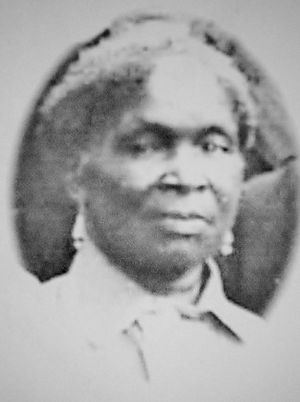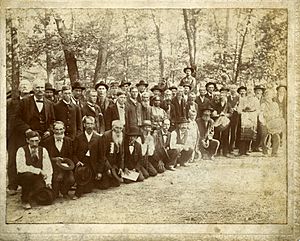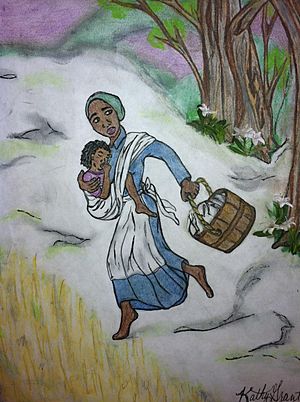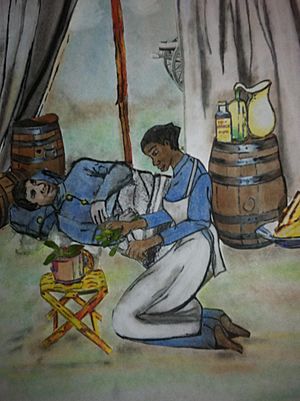Lucy Higgs Nichols facts for kids
Quick facts for kids
Lucy Higgs Nichols
|
|
|---|---|

Lucy Higgs Nichols (detail), in Indianapolis, 1898, with the G.A.R., where she celebrated her recent government pension approval. Stuart B. Wrege History Room, New Albany Floyd - County Public Library
|
|
| Born | April 10, 1838 |
| Died | January 25, 1915 Grays Creek, Tennessee
|
| Nationality | United States |
| Occupation | Nurse |
| Years active | American Civil War |
| Medical career | |
| Institutions | United States Army |
Lucy Higgs Nichols (born April 10, 1838 – died January 25, 1915) was an African American woman who escaped slavery. She became a brave nurse for the Union Army during the American Civil War. Soldiers lovingly called her "Aunt Lucy."
Her only known photo shows her with veterans from the 23rd Indiana Infantry Regiment. She was very dedicated to the soldiers and her daughter, Mona. Lucy lost both her daughter and her first husband during the war. After the war, she settled in New Albany, Indiana. She worked as a housekeeper and later married John Nichols. Lucy lived in New Albany for over 40 years until her death in 1915.
The Grand Army of the Republic (GAR), a group for Civil War veterans, made her their only honorary female member in the entire United States. "Aunt Lucy" was like family to the soldiers. Thanks to their hard work, she received a government pension for her nursing. She served in 28 battles from 1862 until the war ended. She even marched in the victory parades in Washington, D.C., in 1865. Her story was largely forgotten for over 100 years. But in 1898, newspapers across the country shared the news of her special pension, making her famous.
Contents
Lucy's Early Life
For a long time, not much was known about Lucy Higgs' childhood. However, historians from New Albany, Indiana, found important documents. These papers showed that she was born into slavery in Hardeman County, Tennessee.
Records show Lucy was born on April 10, 1838. She was sent to Mississippi as a slave. Later, she was sent back to Tennessee. In 1861, court papers again listed Lucy as property to be divided among slave owners.
Escape and Civil War Service
In June 1862, Lucy, her young daughter Mona, and other enslaved people escaped. They crossed the Hatchie River and reached the Union Army lines near Bolivar, Tennessee. Major Shadrack Hooper of the 23rd Indiana Infantry Regiment wrote about her joining their group. He described her as honest, intelligent, cheerful, and kind. She was a willing washerwoman, seamstress, nurse, cook, and singer. Other soldiers and the army doctor called her a "faithful nurse."
Lucy's first husband also joined the Union lines as a laborer. Sadly, what happened to him is not fully known. Mona, Lucy's daughter, died during the Siege of Vicksburg. The Indiana 23rd Infantry held a funeral for her with flowers.
During the war, when the regiment went home to New Albany, Indiana, Lucy went with them. She worked for several officers, including General W. Q. Gresham. When the soldiers returned to the war, Lucy went back to her nursing duties. She was present at every major battle. She followed General Sherman during his famous Sherman's March to the Sea. She was also with the 23rd Infantry at the Grand Review of the Armies in Washington, D.C.
Life After the War with the Soldiers
After the Emancipation Proclamation, Lucy was a free citizen in New Albany, Indiana. She lived a simple life. She continued to work for officers and helped nurse veterans back to health.
The soldiers loved Lucy very much. Five years after the war, when she got measles, the soldiers cared for her until she recovered. Years later, when she had a stroke, they helped her again. When General Gresham's daughter got married, Lucy was an invited guest. She was truly considered part of the family.

As the Grand Army of the Republic (GAR) formed groups across the country, Lucy became an honorary member of Sanderson's Post. She went to every meeting and reunion with the soldiers. At one meeting with over seventy veterans, the officers escorted her with great respect. Many volunteer nurses during the war did not receive pensions. Lucy was one of them at first. But the GAR fought for her. She was finally granted $12 a month by a special act of Congress in 1898. This made her famous through many newspaper stories.
Personal Life and Later Years
Lucy's second husband, John Nichols, was a free man from Tennessee and Indiana. He served as a musician in the Indiana 152nd Infantry. After the war, he joined a colored regiment before returning to New Albany. Lucy and John married on April 13, 1870. They did not have children together. In 1910, they were still living quietly in New Albany.
Lucy Nichols was admitted to the Floyd County Poor House on January 1, 1915. She passed away there on January 25, 1915. She is buried in an unmarked grave at West Haven Cemetery in New Albany.
Lucy's Legacy
- In 2011, a special marker was put up in her honor. It is located on E. Market St. in New Albany, Indiana. The marker tells a summary of her life and achievements.
- The Carnegie Center for Art & History in New Albany has an exhibit about her. It is called Remembered: the Life of Lucy Higgs Nichols, Men & Women of the Underground Railroad.
- The Frazier History Museum in Louisville, Kentucky, shares Lucy Higgs Nichols' story every year. They do this through programs and local plays.
- A historical novel about Lucy's life, Honorable (Purpose in Repose), was published in 2013. There is also a companion book for younger readers.
Images for kids
-
Group of Civil War and Spanish–American War soldiers and veterans at a reunion in English, Indiana in 1898. Several are identified: front row, 4th from left is Lemuel Ford; front row, 10th from left (dark hat and beard): Winfield Scott Sloan; 2nd row from front, 1st on left: Peter Gottfried; 2nd row 6th from left (long white beard): Henry McCowan; 2nd row, 7th from left (African-American woman): Lucy Nichols; 2nd row, man with largest drum: Tim Ingle. Stuart B. Wrege History Room, New Albany - Floyd County Public Library







